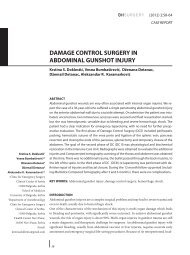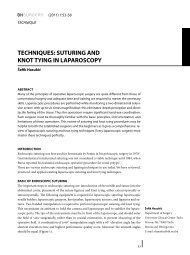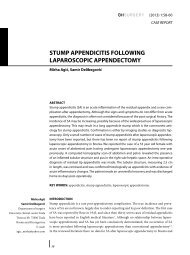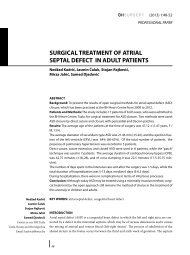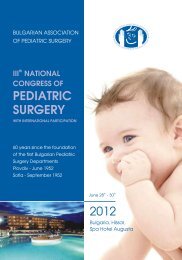complications during and after laparoscopic appendectomy
complications during and after laparoscopic appendectomy
complications during and after laparoscopic appendectomy
You also want an ePaper? Increase the reach of your titles
YUMPU automatically turns print PDFs into web optimized ePapers that Google loves.
Table 1. Intraoperative <strong>and</strong> postoperative <strong>complications</strong> in classical <strong>and</strong> <strong>laparoscopic</strong> <strong>appendectomy</strong><br />
Pathohistological evaluation<br />
Gangrenous<br />
Phlegmonus<br />
Perforated<br />
Diffuse peritonitis<br />
Local peritonitis<br />
Intraoperative complication<br />
Opened cecum 2-3 cm<br />
Bleeding from arteria<br />
appendicularis<br />
Incised taenia<br />
Postoperative complication<br />
Properly coalesced wound<br />
Wound per secundam<br />
Wound infection<br />
Phlegm of wound<br />
Ileus<br />
Intraabdominalni abscess<br />
* <strong>laparoscopic</strong>ally situated<br />
** 5 i 10 mm clips with surgical<br />
*** <strong>laparoscopic</strong>ally situated<br />
Laparoscopic <strong>appendectomy</strong><br />
(n=60)<br />
33 (55%)<br />
27 (45%)<br />
7 (11,6%)<br />
3 (5%)<br />
3 (5%)<br />
1 (1,6%) *<br />
1 (1,6%) **<br />
1 (1,6%) ***<br />
57 (95%)<br />
0<br />
2 (3,3%)<br />
0<br />
0<br />
1 (1,6%)<br />
Classical <strong>appendectomy</strong><br />
(n=60)<br />
28 (46,6%)<br />
31 (51,6%)<br />
18 (30%)<br />
4 (6,6%)<br />
6 (10%)<br />
0<br />
0<br />
0<br />
45 (75%)<br />
9 (15%)<br />
3 (5%)<br />
2 (3,3%)<br />
1 (1,6%)<br />
0<br />
RESULTS<br />
In the group of patients treated by classical <strong>appendectomy</strong><br />
the largest number of them had phlegmonous<br />
changes of the appendix – 31 (51.66%) patients, whereas<br />
gangrenous appendix occurred in 33 (55%). patients<br />
treated with <strong>laparoscopic</strong> method.<br />
Comorbidity <strong>and</strong> intraoperative <strong>complications</strong><br />
Intraoperative <strong>complications</strong> noted in the <strong>laparoscopic</strong><br />
group included a cecum opened for 2-3 cm <strong>and</strong> bleeding<br />
from a branch of the arteria appendicularis <strong>and</strong> an<br />
incised taenia. No intraoperative <strong>complications</strong> were<br />
noted in the group of patients treated by the classical<br />
method.<br />
Postoperative <strong>complications</strong><br />
Among the patients treated with the CA, 3 (5%), had<br />
a wound infection, 2 (3.3%) experienced phlegmon of<br />
the surgical wound, 9 (15%) had a wound healing per<br />
secundam, <strong>and</strong> ileus occurred in 1 patient (1.6%). Two<br />
LA patients (3.3%) had an infection of the umbilical<br />
wound. Intraabdominal abscess occurred in LA in one<br />
patient (1.6%) (Table 1.).<br />
DISCUSSION<br />
Laparoscopic <strong>appendectomy</strong> has proven advantages<br />
over the open method. The risk of infection is lower,<br />
postoperative pain is less severe, <strong>and</strong> the hospital stay<br />
is shorter.<br />
Intraoperative <strong>complications</strong> were noted in the group of<br />
51



